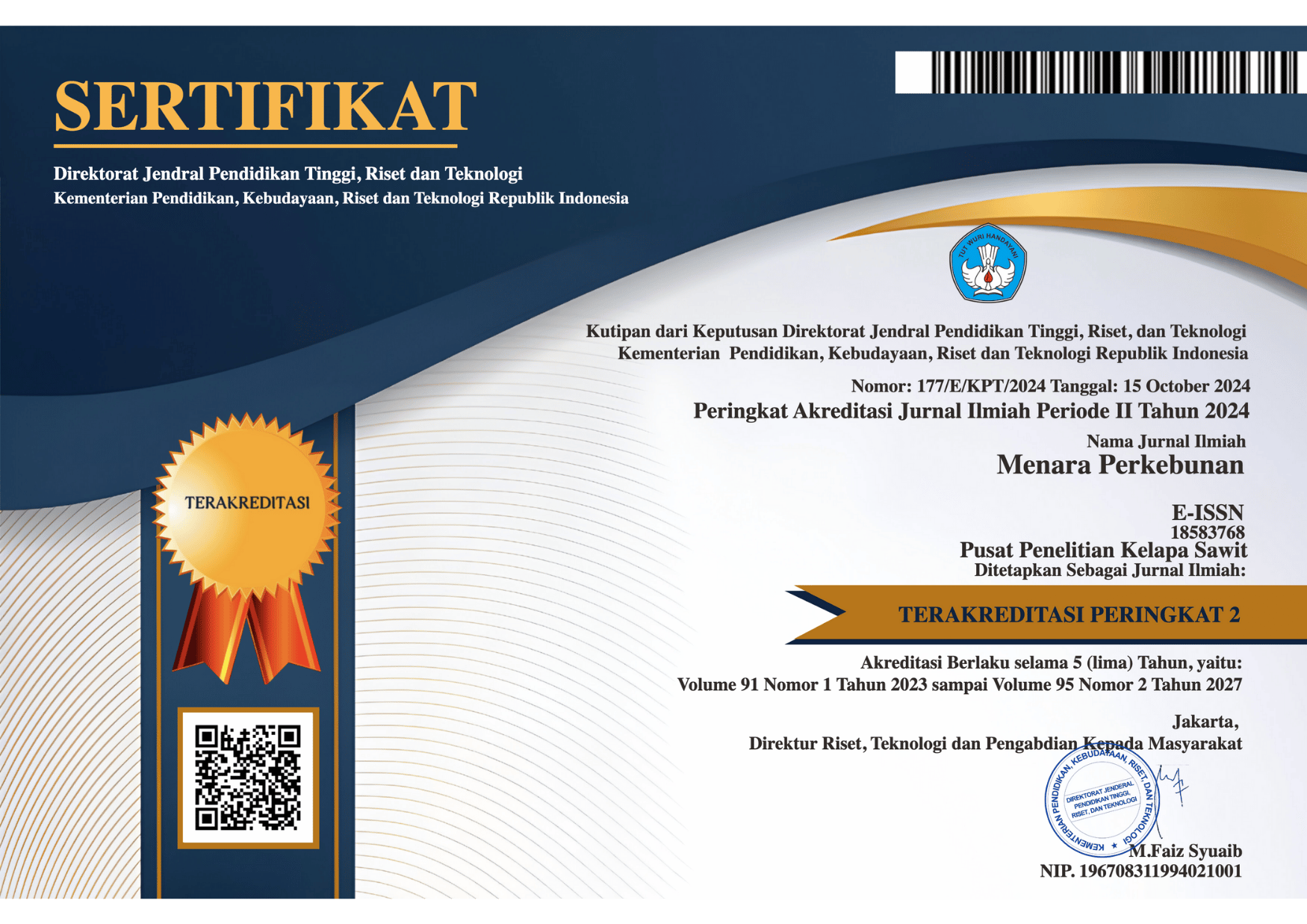Isolation and characterization of Dehydrin promoter region from sugarcane (Saccharum officinarum L.)
DOI:
https://doi.org/10.22302/iribb.jur.mp.v88i1.363Keywords:
drought stress, DHN, promoter, Saccharum spAbstract
The development of molecular biology techniques nowadays has enabled to engineer drought tolerant sugarcane by genetic engineering to accelerate the breeding program. Dehydrin (DHN) is known to have an important role in plant response and adaptation to abiotic stresses (drought, high salinity, cold, heat, etc.). While plant tissues are subjected to drought stress (dehydration), DHN protein is accumulated to high content throughout all vegetative or generative tissues. The research aimed to isolate and characterize the DHN promoter from sugarcane that can be used as transformation material in generating drought tolerant sugarcane. Specific primers for DHN promoter amplification were designed and DHN promoter region was successfully isolated by PCR cloning method. Two putative promoter sequences were identified namely Pr-1DHNSo and Pr-2DHNSo. In silicoanalyses were carried out and cis-regulatory elements motifs that play a role in adaptation on abiotic stress as well as biotic stress including ABRE, MBS, CGTCA-motif, TGACG-motif, GARE-motif, P-box TCA-element and Box-W1 were identified. The promoter Pr-1DHNSo was then cloned into pBI121 expression vector by Overlap Extention PCR (OE-PCR) for further characterization. Functional test of the promoter construct pBI- Pr-1DHNSo was conducted through Agrobacterium transformation into sugarcane calli. GUS assay and PCR analysis showed that the DHN promoter was transformed and expressed in the sugarcane calli.Downloads
References
Bray, E.A. 1997. Plant responses to water deficit. Reviews. Trends in Plant Sci. 2 (2), 48-54.
Beringer, J.E. 2000. Releasing genetically modified organism: will any harm out weigh any advantage? J. Applied Ecology 37: 207-214.
Bryksin, A.V. and I. Matsumura (2010). Overlap extension PCR cloning: a simple and reliable way to create recombinant plasmids. BioTechniques, 48: 463-465. doi 10.2144/000113418.
Carrer H, TN Hockenberry, Z Svab & P Maliga (1993). Kanamycin resistance as a selectable marker for plastid transformation in tobacco. Mol Gen Genet 241(1-2), 49-56.
Chaves, M.M., J.P. Maroco, and J.S. Pereira, 2003.Understanding plant responses to drought - from genes to the whole plant. Funct Plant Biol, 30, 239-264.
Conner, A.J. 1997.Genetically engineered crops, evironmental & food safety issues.The Royal Society of New Zealand, Wellington. 34p.
Hanahan, D. (1983). Studies on transformation of Escherichia coli with plasmids. J Mol Biol. 166(4), 557-580.
Hanin, M., F. Brini, C. Ebel, Y. Toda, S. Takeda, and K. Masmoudi. 2011. Plant dehydrins and stress tolerance. Versatile protein for complex mechanisms.Plant Signaling and Behavior,6: 10, 1503-1509.
Iskandar, H.M, R.E. Casu, A.T. Fletcher, S. Schmidt, J. Xu, D.J. Maclean, J.M. Manners, and G. D. Bonnett. 2011. Identification of drought-response genes and a study of their expression during sucrose accumulation and water deficit in sugarcane culms. BMC Plant Biology 11 : 12 (1-14).
Iskandar, HM, Widyaningrum, D, & Suhandono, S. Cloning and Characterization of P5CS1 and P5CS2 genes from Saccharum officinarum L under drought stress. (2014) J Tropical Crop Sci, 1(1): 23-30
Jefferson R (1987). Assaying chimeric genes in plants: The GUS gene fusion system. Plant Mol Biol Reporter 5, 387-405.
Jouanin, L, ACM Brasileiro, JC Leple, G Pilate & D Cornu (1993). Genetic transformation: a short review of methods and their application, results and perspectives for forest trees. Ann. Forest Sci. 50, 325-336.
Murashige T. & Skoog F. (1962) A revised medium for rapid growth and biassays with tobacco tissue culture. Physiol Plant 15: 473-497.
Orozco-Castillo, C.K.J. R. Chalmers, W. Waugh, and W. Powell. 1994. Detection of genetic diversity and selective gen introgression in coffee using RAPD markers. Theor Appl Genet. 8:934-940.
Putranto, R. A., C. Sanier, J. Leclercq, C. Duan, M. Rio, C. Jourdan, P. Thaler, X. Sabau, X. Argout & P. Montoro (2012) Differential gene expression in different types of Hevea brasiliensis roots. Plant Sci, 183, 149-58.
Sain, SL, KK Oduro & DB Furtex (1994). Genetic transformation of cocoa leaf cells using Agrobacterium tumefaciens. PCTOC 37, 243-251.
Sambrook, J., E.F. Fritch, T. Maniatis. 1989. Molecular Cloning: a Laboratory Manual. second edition, Cold Spring Harbor Laboratory Press, Cold Spring Harbor.
Sasmito, D.E.K.; R. Kurniawan; & I. Muhimmah. 2014. "Karakteristik Primer pada Polymerase Chain Reaction (PCR) untuk Sekuensing DNA: Mini Riview."SNIMed Vol 2014.
Strijker, D. 2004. Marginal lands in Europe-causes of decline. Basic and Applied Ecology(6) : 99-106Thompson, L. 2000. Are bioengineered foods safe? FDA Consumer Magazine, January-February 2000.
Taylor, R.G., D.C. Walker, and R.R. McInnes. (1993). E. coli host strains significantly affect the quality of small scale plasmid DNA preparations used for sequencing. Nuc. Acid Res. 21(7): 1677-1678.
Thompson, L. 2000. Are bioengineered foods safe? FDA Consumer Magazine, January-February 2000.
Wang K (2006). Agrobacterium Protocols Second Edition. Totowa, Humana Press.
Yu, T., Z. Wang, X. Jin, X. Liu & S. Kan (2014) Analysis of gene expression profiles in response to Sporisorium reilianum f. sp. zeae in maize (Zea mays L.). Electronic Journal of Biotechnology, 17, 230-237.
Downloads
Submitted
Accepted
Published
How to Cite
Issue
Section
License
Authors retain copyright and grant the journal right of first publication with the work simultaneously licensed under a Creative Commons Attribution License that allows others to share the work with an acknowledgement of the work's authorship and initial publication in this journal.













